A small part of our European film star postcard collection is formed by vintage cigarette cards - small, colourful treasures from the past. During the 1930s, Ross-Verlag in Berlin produced several series for German cigarette manufacturers. The cards were included in the cigarette packets and could be glued in special albums. For Zigarettenfabrik Monopol in Dresden, Ross made in the mid-1930s the series 'Künstler im Film' (Artists in Film) with 200 cards of 5,5 cm by 6,5 cm. In this post, EFSP reproduces 28 of the cards with international stars. The backsides contain info about when the star was born, how you could contact him or her (mostly through the studio) and the title(s) of his or her latest film(s).
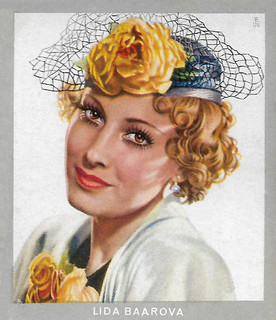
German cigarette card by Ross Verlag in the 'Künstler im Film' series for Zigarettenfabrik Monopol, Dresden, Serie 1, image 1. Photo: Ufa.
Beautiful Lída Baarová (1914-2000) was a glamorous Czech film star who worked in Prague, Berlin, and Rome. A dangerous affair with Joseph Goebbels, the propaganda minister of the Third Reich, first enhanced and later seriously damaged her career.
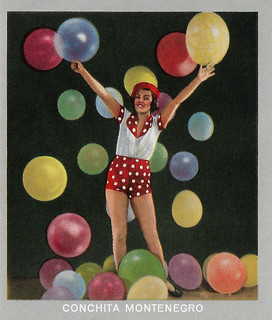
German cigarette card by Ross Verlag in the 'Künstler im Film' series for Zigarettenfabrik Monopol, Dresden, Serie 1, image 8. Photo: Metro-Goldwyn-Mayer.
Conchita Montenegro (1911-2007) was a Spanish model, dancer, and stage and screen actress. She starred in several Spanish productions, but also in French, German and American films.

German cigarette card by Ross Verlag in the 'Künstler im Film' series for Zigarettenfabrik Monopol, Dresden, Serie 1, image 13 (of 200). Photo: Ufa.
German actress Carola Höhn (1910-2005) had a 60 years lasting film career. She began as the elegant star of many Ufa productions and later became the acclaimed Grande Dame of the German post-war cinema.

German cigarette card by Ross Verlag in the 'Künstler im Film' series for Zigarettenfabrik Monopol, Dresden, Serie 1, image 18. Photo: Metro-Goldwyn-Mayer. Greta Garbo in The Painted Veil (Richard Boleslawski, 1934).
Swedish Greta Garbo (1905-1990) was one of the greatest and most glamorous film stars ever produced by the Hollywood studio system. She was part of the Golden Age of the silent cinema of the 1920s and was one of the few actors who made a glorious transition to the talkies. She started her career in the European cinema and would always stay more popular in Europe than in the USA.
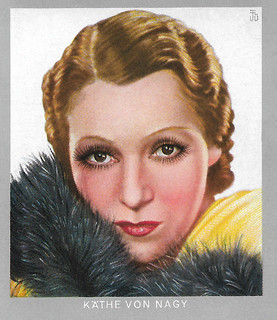
German cigarette card by Ross Verlag in the 'Künstler im Film' series for Zigarettenfabrik Monopol, Dresden, Serie 1, image 30 (of 200). Photo: Itala-Film.
Hungarian actress Käthe von Nagy (1904-1973) started as the ‘Backfish’ of German films of the late 1920s. In the early 1930s, she became a fashionable and charming star of German and French cinema.

German cigarette card by Ross Verlag in the 'Künstler im Film' series for Zigarettenfabrik Monopol, Dresden, Serie 1, image 39 (of 200). Photo: Ufa.
Egyptian-born singer, dancer, and actress of Hungarian descent Marika Rökk (1913-2004) was the last film diva of the Ufa. She was an immensely talented musical performer who could tap with the rhythm and vitality of her Hollywood counterpart Eleanor Powell, and switch to balletic movements with the conviction of Cyd Charisse. Her trademark was her Hungarian accent.

German cigarette card by Ross Verlag in the 'Künstler im Film' series for Zigarettenfabrik Monopol, Dresden, Serie 1, image 41 (of 200). Photo: Gloria-Syndikat.
Glamorous, mysterious diva Zarah Leander (1907-1981) was a Swedish actress and singer, who is now best remembered for her German songs and films from the late 1930s and early 1940s. With her fascinating and deep voice, she sang melancholic and a bit frivolous songs that were specifically composed for her. Zarah was for a time the best-paid film star of the Third Reich. In her Ufa vehicles, she always played the role of a cool femme fatale, independently minded, beautiful, passionate, self-confident and a bit sad. It gave her the nickname 'the Nazi Garbo', but a recent book claims that she was, in fact, a Soviet spy.

German cigarette card by Ross Verlag in the 'Künstler im Film' series for Zigarettenfabrik Monopol, Dresden, Serie 1, image 88 (from 200). Photo: Metro-Goldwyn-Mayer. Greta Garbo in Camille (George Cukor, 1936).
Swedish Greta Garbo (1905-1990) was one of the greatest and most glamorous film stars ever produced by the Hollywood studio system. She was part of the Golden Age of the silent cinema of the 1920s and was one of the few actors who made a glorious transition to the talkies. She started her career in the European cinema and would always stay more popular in Europe than in the USA.

German cigarette card by Ross Verlag in the 'Künstler im Film' series for Zigarettenfabrik Monopol, Dresden, Serie 1, image 104 (of 200). Photo: 20th Century Fox.
American actress Sally Eilers (1908-1978) was a popular Hollywood star in the early-1930s. She was tagged 'the most beautiful girl in movies'.

German cigarette card by Ross Verlag in the 'Künstler im Film' series for Zigarettenfabrik Monopol, Dresden, Serie 1, image 110 (of 200). Photo: Manassé-Ricoll. Hans Moser in Der Dienstmann (Adolf Rosen, 1932).
Austrian actor Hans Moser (1880-1964) appeared in over 150 films. During his long career, from the 1920s up to his death, he became very popular as the mumbling factotum in comedy films. Moser was particularly associated with the genre of the Wiener Film.
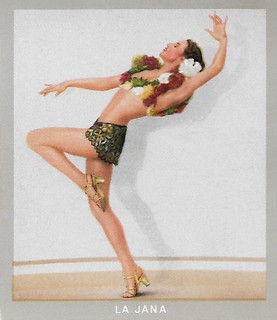
German cigarette card by Ross Verlag in the 'Künstler im Film' series for Zigarettenfabrik Monopol, Dresden, Serie 1, image 115 (of 200). Photo: Dührkoop.
Sexy German dancer and film actress La Jana (1905-1940) was the most popular showgirl in Berlin in the 1930s. She appeared in 25 European films, often dancing in exotic costumes. In 1940, she suddenly died of pneumonia and pleurisy.
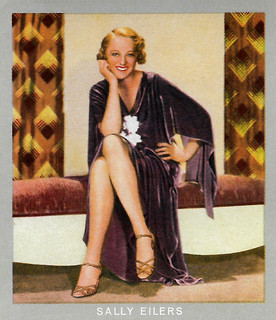
German cigarette card by Ross Verlag in the 'Künstler im Film' series for Zigarettenfabrik Monopol, Dresden, Serie 1, image 116 (of 200). Photo: Fox-Film.
American actress Sally Eilers (1908-1978) was a popular Hollywood star in the early-1930s. She was tagged 'the most beautiful girl in movies'.

German cigarette card by Ross Verlag in the 'Künstler im Film' series for Zigarettenfabrik Monopol, Dresden, Serie 1, image 121. Photo: Ariel / Tobis / Rota.
Russian-born ballet dancer and actress Genia Nikolaieva (1904-2001) worked in the German cinema during the 1930s. In 1938 she emigrated to the United States, where she became ‘one of the most beautiful studio secretaries for Warner Bros'.
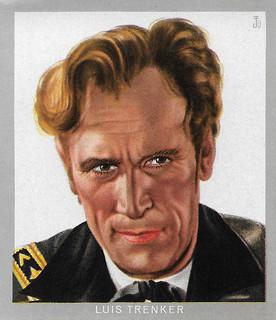
German cigarette card by Ross Verlag in the 'Künstler im Film' series for Zigarettenfabrik Monopol, Dresden, Serie 1, image 125 (of 200). Photo: Trenker / Tobis / Rota.
Luis Trenker (1892-1990) was an Austrian-Italian ski champion, mountain climber, architect, film director, and actor. He portrayed rugged, daring outdoorsmen in the Mountain Film, the genre which seemed to be created especially for him. His films glorified epic struggles such as colonization and wars for freedom and were set against spectacular, usually mountainous landscapes.

German cigarette card by Ross Verlag in the 'Künstler im Film' series for Zigarettenfabrik Monopol, Dresden, Serie 1, image 130. Photo: Ufa
Grethe Weiser (1903-1970) was a German singer, comedian, film and stage actress. She made more than 140 films.
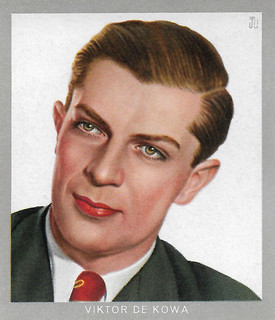
German cigarette card by Ross Verlag in the 'Künstler im Film' series for Zigarettenfabrik Monopol, Dresden, Serie 1, image 133 (of 200). Photo: Binder, Berlin.
Viktor de Kowa (1904-1973) was a German actor, singer, director and comedy writer. In the 1930s he became one of the most prominent and beloved comedy actors of the German cinema.

German cigarette card by Ross Verlag in the 'Künstler im Film' series for Zigarettenfabrik Monopol, Dresden, Serie 1, image 134 (of 200). Photo: Paramount.
Ketti Gallian (1912-1972) was a blonde French actress, who starred in films by Paramount and Fox during the 1930s. Her Hollywood career was not a success and she returned to France, where she acted in films till 1956.

German cigarette card by Ross Verlag in the 'Künstler im Film' series for Zigarettenfabrik Monopol, Dresden, Serie 1, image 141 (of 200). Photo: Paramount.
Grace Bradley (1913-2010) was a petite, seductive and sassy American actress who played 'good-time' girls in many second-feature thrillers and musicals of the 1930s and 1940s. She was the fifth and last wife of William 'Hoppalong Cassidy' Boyd.

German cigarette card by Ross Verlag in the 'Künstler im Film' series for Zigarettenfabrik Monopol, Dresden, Serie 1, image 143 (of 200). Photo: Metro-Goldwyn-Mayer Studios.
American film actress Jean Harlow (1911–1937) was one of the sex symbols of the 1930s.
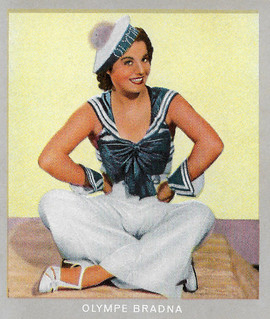
German cigarette card by Ross Verlag in the 'Künstler im Film' series for Zigarettenfabrik Monopol, Dresden, Serie 1, image 146 (of 200). Photo: Paramount.
Brunette Olympe Bradna (1920-2012) was a French dancer and actress, who danced in Paris, Stockholm, New York City, and other world capitals. In Hollywood, she appeared in more than a dozen films and starred opposite Ronald Reagan, George Raft and Gary Cooper. In the majority of her films, she played the ornamental love interest of sporting champs or war heroes and had little else to do.
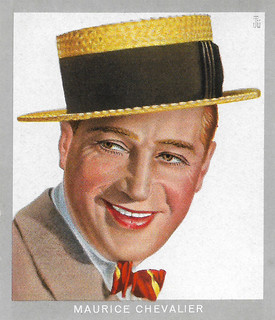
German cigarette card by Ross Verlag in the 'Künstler im Film' series for Zigarettenfabrik Monopol, Dresden, Serie 1, image 148 (of 200). Photo: Paramount.
Maurice Chevalier (1888-1972) was a French actor, singer, and entertainer with a very successful Hollywood career. His trademark was a casual straw hat, which he always wore on stage with a cane and a tuxedo.

German cigarette card by Ross Verlag in the 'Künstler im Film' series for Zigarettenfabrik Monopol, Dresden, Serie 1, image 152 (of 200). Photo: Paramount. Lupe Velez in The Broken Wing (Lloyd Corrigan, 1932).
Lupe Velez (1908-1944), was one of the first Mexican actresses to succeed in Hollywood. Her nicknames were 'The Mexican Spitfire' and 'Hot Pepper'. She was the leading lady in such silent films as The Gaucho (1927), Lady of the Pavements (1928), and Wolf Song (1929). During the 1930s, her well-known explosive screen persona was exploited in a series of successful films like Hot Pepper (1933), Strictly Dynamite (1934), and Hollywood Party (1934). In the 1940s, Vélez's popularity peaked after appearing in the Mexican Spitfire films, a series created to capitalise on Vélez's well-documented fiery personality. She had several highly publicised romances and a stormy marriage. In 1944, Vélez died of an intentional overdose of the barbiturate drug Seconal. Her death and the circumstances surrounding it have been the subject of speculation and controversy.

German cigarette card by Ross Verlag in the 'Künstler im Film' series for Zigarettenfabrik Monopol, Dresden, Serie 1, image 162 (of 200). Photo: Metro-Goldwyn-Mayer.
American screen legend Gary Cooper (1901-1961) is well remembered for his stoic, understated acting style in more than one hundred Westerns, comedies and dramas. He received five Oscar nominations and won twice for his roles as Alvin York in Sergeant York (1941) and as Will Kane in High Noon (1952).

German cigarette card by Ross Verlag in the 'Künstler im Film' series for Zigarettenfabrik Monopol, Dresden, Serie 1, image 164 (of 200). Photo: 20th Century Fox.
American actress Claire Trevor (1910-2000) appeared in 68 feature films from 1933 to 1982. She often played the hard-boiled blonde or another type of shady lady. She won the Oscar for Best Supporting Actress for her role in Key Largo (1948) and received nominations for her roles in Dead End (1937) and The High and the Mighty (1954). But she is now best known for John Ford's classic Western Stagecoach (1939) with John Wayne.

German cigarette card by Ross Verlag in the 'Künstler im Film' series for Zigarettenfabrik Monopol, Dresden, Serie 1, image 172 (of 200). Photo: Mondial-Film.
Austrian child actress Traudl Stark (1930) was the Shirley Temple of the German cinema. Between 1935 and 1940 she made a dozen popular films in Austria.

German cigarette card by Ross Verlag in the 'Künstler im Film' series for Zigarettenfabrik Monopol, Dresden, Serie 1, image 189 (of 200). Photo: Syndikat-Film.
Austrian actor Hans Moser (1880-1964) appeared in over 150 films. During his long career, from the 1920s up to his death, he became very popular as the mumbling factotum in comedy films. Moser was particularly associated with the genre of the Wiener Film.

German cigarette card by Ross Verlag in the 'Künstler im Film' series for Zigarettenfabrik Monopol, Dresden, Serie 1, image 192 (of 200). Photo: Metro-Goldwyn-Mayer. The Dodge Sisters in The March of Time (Charles Reisner, 1931)
The Dodge Sisters were two American showgirls, who were known in the USA and Europe during the Jazz Age as ‘the two birds of Paradise’. The Dodge Twins sang and danced dressed as birds and whistled. They seemingly emerged out of nowhere in the mid-1920s with a singing and dancing act that took Europe by storm. Beth and Betty Dodge were known for such films as Die schönsten Beine von Berlin/The most beautiful legs of Berlin (1927), Unter Ausschluß der Öffentlichkeit/Closed to the public (1927), and Wir schalten um auf Hollywood/We switch to Hollywood (1931).

German cigarette card by Ross Verlag in the 'Künstler im Film' series for Zigarettenfabrik Monopol, Dresden, Serie 1, image 199 (of 200). Photo: Metro-Goldwyn-Mayer.
Betty Furness (1916-1994) was an American actress, a consumer advocate, and a current affairs commentator.
The Ross Tribute will be continued next week!

German cigarette card by Ross Verlag in the 'Künstler im Film' series for Zigarettenfabrik Monopol, Dresden, Serie 1, image 1. Photo: Ufa.
Beautiful Lída Baarová (1914-2000) was a glamorous Czech film star who worked in Prague, Berlin, and Rome. A dangerous affair with Joseph Goebbels, the propaganda minister of the Third Reich, first enhanced and later seriously damaged her career.

German cigarette card by Ross Verlag in the 'Künstler im Film' series for Zigarettenfabrik Monopol, Dresden, Serie 1, image 8. Photo: Metro-Goldwyn-Mayer.
Conchita Montenegro (1911-2007) was a Spanish model, dancer, and stage and screen actress. She starred in several Spanish productions, but also in French, German and American films.

German cigarette card by Ross Verlag in the 'Künstler im Film' series for Zigarettenfabrik Monopol, Dresden, Serie 1, image 13 (of 200). Photo: Ufa.
German actress Carola Höhn (1910-2005) had a 60 years lasting film career. She began as the elegant star of many Ufa productions and later became the acclaimed Grande Dame of the German post-war cinema.

German cigarette card by Ross Verlag in the 'Künstler im Film' series for Zigarettenfabrik Monopol, Dresden, Serie 1, image 18. Photo: Metro-Goldwyn-Mayer. Greta Garbo in The Painted Veil (Richard Boleslawski, 1934).
Swedish Greta Garbo (1905-1990) was one of the greatest and most glamorous film stars ever produced by the Hollywood studio system. She was part of the Golden Age of the silent cinema of the 1920s and was one of the few actors who made a glorious transition to the talkies. She started her career in the European cinema and would always stay more popular in Europe than in the USA.

German cigarette card by Ross Verlag in the 'Künstler im Film' series for Zigarettenfabrik Monopol, Dresden, Serie 1, image 30 (of 200). Photo: Itala-Film.
Hungarian actress Käthe von Nagy (1904-1973) started as the ‘Backfish’ of German films of the late 1920s. In the early 1930s, she became a fashionable and charming star of German and French cinema.

German cigarette card by Ross Verlag in the 'Künstler im Film' series for Zigarettenfabrik Monopol, Dresden, Serie 1, image 39 (of 200). Photo: Ufa.
Egyptian-born singer, dancer, and actress of Hungarian descent Marika Rökk (1913-2004) was the last film diva of the Ufa. She was an immensely talented musical performer who could tap with the rhythm and vitality of her Hollywood counterpart Eleanor Powell, and switch to balletic movements with the conviction of Cyd Charisse. Her trademark was her Hungarian accent.

German cigarette card by Ross Verlag in the 'Künstler im Film' series for Zigarettenfabrik Monopol, Dresden, Serie 1, image 41 (of 200). Photo: Gloria-Syndikat.
Glamorous, mysterious diva Zarah Leander (1907-1981) was a Swedish actress and singer, who is now best remembered for her German songs and films from the late 1930s and early 1940s. With her fascinating and deep voice, she sang melancholic and a bit frivolous songs that were specifically composed for her. Zarah was for a time the best-paid film star of the Third Reich. In her Ufa vehicles, she always played the role of a cool femme fatale, independently minded, beautiful, passionate, self-confident and a bit sad. It gave her the nickname 'the Nazi Garbo', but a recent book claims that she was, in fact, a Soviet spy.

German cigarette card by Ross Verlag in the 'Künstler im Film' series for Zigarettenfabrik Monopol, Dresden, Serie 1, image 88 (from 200). Photo: Metro-Goldwyn-Mayer. Greta Garbo in Camille (George Cukor, 1936).
Swedish Greta Garbo (1905-1990) was one of the greatest and most glamorous film stars ever produced by the Hollywood studio system. She was part of the Golden Age of the silent cinema of the 1920s and was one of the few actors who made a glorious transition to the talkies. She started her career in the European cinema and would always stay more popular in Europe than in the USA.

German cigarette card by Ross Verlag in the 'Künstler im Film' series for Zigarettenfabrik Monopol, Dresden, Serie 1, image 104 (of 200). Photo: 20th Century Fox.
American actress Sally Eilers (1908-1978) was a popular Hollywood star in the early-1930s. She was tagged 'the most beautiful girl in movies'.

German cigarette card by Ross Verlag in the 'Künstler im Film' series for Zigarettenfabrik Monopol, Dresden, Serie 1, image 110 (of 200). Photo: Manassé-Ricoll. Hans Moser in Der Dienstmann (Adolf Rosen, 1932).
Austrian actor Hans Moser (1880-1964) appeared in over 150 films. During his long career, from the 1920s up to his death, he became very popular as the mumbling factotum in comedy films. Moser was particularly associated with the genre of the Wiener Film.

German cigarette card by Ross Verlag in the 'Künstler im Film' series for Zigarettenfabrik Monopol, Dresden, Serie 1, image 115 (of 200). Photo: Dührkoop.
Sexy German dancer and film actress La Jana (1905-1940) was the most popular showgirl in Berlin in the 1930s. She appeared in 25 European films, often dancing in exotic costumes. In 1940, she suddenly died of pneumonia and pleurisy.

German cigarette card by Ross Verlag in the 'Künstler im Film' series for Zigarettenfabrik Monopol, Dresden, Serie 1, image 116 (of 200). Photo: Fox-Film.
American actress Sally Eilers (1908-1978) was a popular Hollywood star in the early-1930s. She was tagged 'the most beautiful girl in movies'.

German cigarette card by Ross Verlag in the 'Künstler im Film' series for Zigarettenfabrik Monopol, Dresden, Serie 1, image 121. Photo: Ariel / Tobis / Rota.
Russian-born ballet dancer and actress Genia Nikolaieva (1904-2001) worked in the German cinema during the 1930s. In 1938 she emigrated to the United States, where she became ‘one of the most beautiful studio secretaries for Warner Bros'.

German cigarette card by Ross Verlag in the 'Künstler im Film' series for Zigarettenfabrik Monopol, Dresden, Serie 1, image 125 (of 200). Photo: Trenker / Tobis / Rota.
Luis Trenker (1892-1990) was an Austrian-Italian ski champion, mountain climber, architect, film director, and actor. He portrayed rugged, daring outdoorsmen in the Mountain Film, the genre which seemed to be created especially for him. His films glorified epic struggles such as colonization and wars for freedom and were set against spectacular, usually mountainous landscapes.

German cigarette card by Ross Verlag in the 'Künstler im Film' series for Zigarettenfabrik Monopol, Dresden, Serie 1, image 130. Photo: Ufa
Grethe Weiser (1903-1970) was a German singer, comedian, film and stage actress. She made more than 140 films.

German cigarette card by Ross Verlag in the 'Künstler im Film' series for Zigarettenfabrik Monopol, Dresden, Serie 1, image 133 (of 200). Photo: Binder, Berlin.
Viktor de Kowa (1904-1973) was a German actor, singer, director and comedy writer. In the 1930s he became one of the most prominent and beloved comedy actors of the German cinema.

German cigarette card by Ross Verlag in the 'Künstler im Film' series for Zigarettenfabrik Monopol, Dresden, Serie 1, image 134 (of 200). Photo: Paramount.
Ketti Gallian (1912-1972) was a blonde French actress, who starred in films by Paramount and Fox during the 1930s. Her Hollywood career was not a success and she returned to France, where she acted in films till 1956.

German cigarette card by Ross Verlag in the 'Künstler im Film' series for Zigarettenfabrik Monopol, Dresden, Serie 1, image 141 (of 200). Photo: Paramount.
Grace Bradley (1913-2010) was a petite, seductive and sassy American actress who played 'good-time' girls in many second-feature thrillers and musicals of the 1930s and 1940s. She was the fifth and last wife of William 'Hoppalong Cassidy' Boyd.

German cigarette card by Ross Verlag in the 'Künstler im Film' series for Zigarettenfabrik Monopol, Dresden, Serie 1, image 143 (of 200). Photo: Metro-Goldwyn-Mayer Studios.
American film actress Jean Harlow (1911–1937) was one of the sex symbols of the 1930s.

German cigarette card by Ross Verlag in the 'Künstler im Film' series for Zigarettenfabrik Monopol, Dresden, Serie 1, image 146 (of 200). Photo: Paramount.
Brunette Olympe Bradna (1920-2012) was a French dancer and actress, who danced in Paris, Stockholm, New York City, and other world capitals. In Hollywood, she appeared in more than a dozen films and starred opposite Ronald Reagan, George Raft and Gary Cooper. In the majority of her films, she played the ornamental love interest of sporting champs or war heroes and had little else to do.

German cigarette card by Ross Verlag in the 'Künstler im Film' series for Zigarettenfabrik Monopol, Dresden, Serie 1, image 148 (of 200). Photo: Paramount.
Maurice Chevalier (1888-1972) was a French actor, singer, and entertainer with a very successful Hollywood career. His trademark was a casual straw hat, which he always wore on stage with a cane and a tuxedo.

German cigarette card by Ross Verlag in the 'Künstler im Film' series for Zigarettenfabrik Monopol, Dresden, Serie 1, image 152 (of 200). Photo: Paramount. Lupe Velez in The Broken Wing (Lloyd Corrigan, 1932).
Lupe Velez (1908-1944), was one of the first Mexican actresses to succeed in Hollywood. Her nicknames were 'The Mexican Spitfire' and 'Hot Pepper'. She was the leading lady in such silent films as The Gaucho (1927), Lady of the Pavements (1928), and Wolf Song (1929). During the 1930s, her well-known explosive screen persona was exploited in a series of successful films like Hot Pepper (1933), Strictly Dynamite (1934), and Hollywood Party (1934). In the 1940s, Vélez's popularity peaked after appearing in the Mexican Spitfire films, a series created to capitalise on Vélez's well-documented fiery personality. She had several highly publicised romances and a stormy marriage. In 1944, Vélez died of an intentional overdose of the barbiturate drug Seconal. Her death and the circumstances surrounding it have been the subject of speculation and controversy.

German cigarette card by Ross Verlag in the 'Künstler im Film' series for Zigarettenfabrik Monopol, Dresden, Serie 1, image 162 (of 200). Photo: Metro-Goldwyn-Mayer.
American screen legend Gary Cooper (1901-1961) is well remembered for his stoic, understated acting style in more than one hundred Westerns, comedies and dramas. He received five Oscar nominations and won twice for his roles as Alvin York in Sergeant York (1941) and as Will Kane in High Noon (1952).

German cigarette card by Ross Verlag in the 'Künstler im Film' series for Zigarettenfabrik Monopol, Dresden, Serie 1, image 164 (of 200). Photo: 20th Century Fox.
American actress Claire Trevor (1910-2000) appeared in 68 feature films from 1933 to 1982. She often played the hard-boiled blonde or another type of shady lady. She won the Oscar for Best Supporting Actress for her role in Key Largo (1948) and received nominations for her roles in Dead End (1937) and The High and the Mighty (1954). But she is now best known for John Ford's classic Western Stagecoach (1939) with John Wayne.

German cigarette card by Ross Verlag in the 'Künstler im Film' series for Zigarettenfabrik Monopol, Dresden, Serie 1, image 172 (of 200). Photo: Mondial-Film.
Austrian child actress Traudl Stark (1930) was the Shirley Temple of the German cinema. Between 1935 and 1940 she made a dozen popular films in Austria.

German cigarette card by Ross Verlag in the 'Künstler im Film' series for Zigarettenfabrik Monopol, Dresden, Serie 1, image 189 (of 200). Photo: Syndikat-Film.
Austrian actor Hans Moser (1880-1964) appeared in over 150 films. During his long career, from the 1920s up to his death, he became very popular as the mumbling factotum in comedy films. Moser was particularly associated with the genre of the Wiener Film.

German cigarette card by Ross Verlag in the 'Künstler im Film' series for Zigarettenfabrik Monopol, Dresden, Serie 1, image 192 (of 200). Photo: Metro-Goldwyn-Mayer. The Dodge Sisters in The March of Time (Charles Reisner, 1931)
The Dodge Sisters were two American showgirls, who were known in the USA and Europe during the Jazz Age as ‘the two birds of Paradise’. The Dodge Twins sang and danced dressed as birds and whistled. They seemingly emerged out of nowhere in the mid-1920s with a singing and dancing act that took Europe by storm. Beth and Betty Dodge were known for such films as Die schönsten Beine von Berlin/The most beautiful legs of Berlin (1927), Unter Ausschluß der Öffentlichkeit/Closed to the public (1927), and Wir schalten um auf Hollywood/We switch to Hollywood (1931).

German cigarette card by Ross Verlag in the 'Künstler im Film' series for Zigarettenfabrik Monopol, Dresden, Serie 1, image 199 (of 200). Photo: Metro-Goldwyn-Mayer.
Betty Furness (1916-1994) was an American actress, a consumer advocate, and a current affairs commentator.
The Ross Tribute will be continued next week!
No comments:
Post a Comment